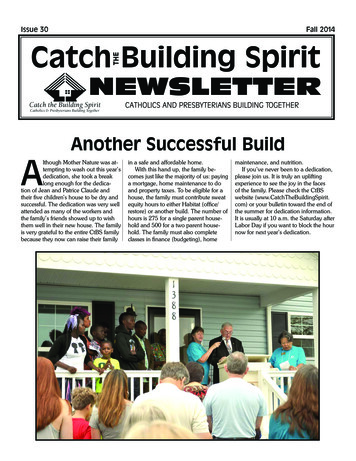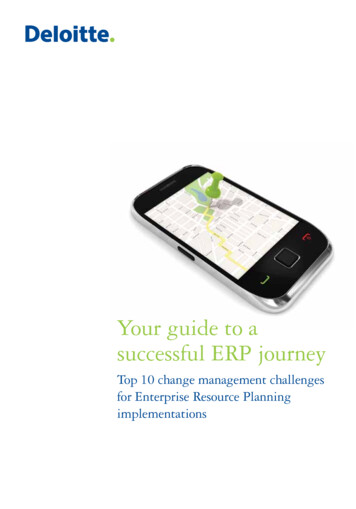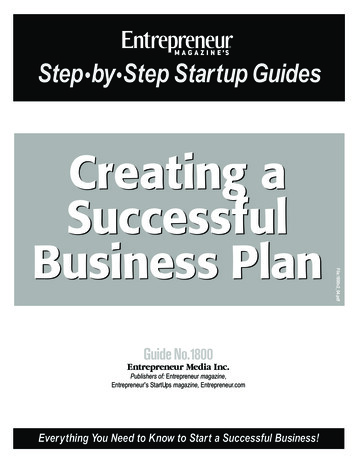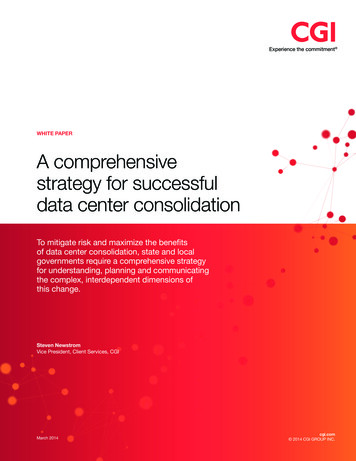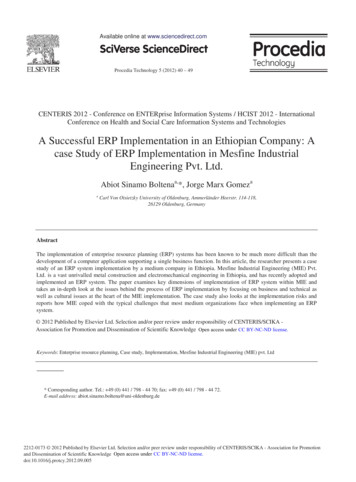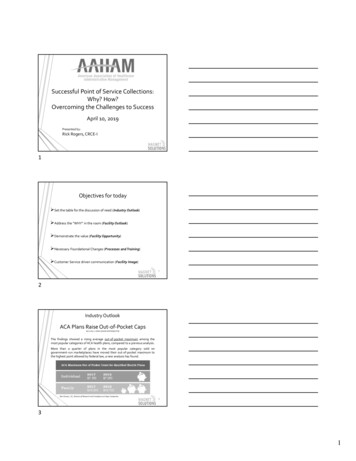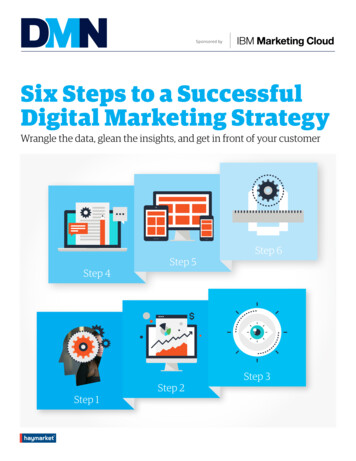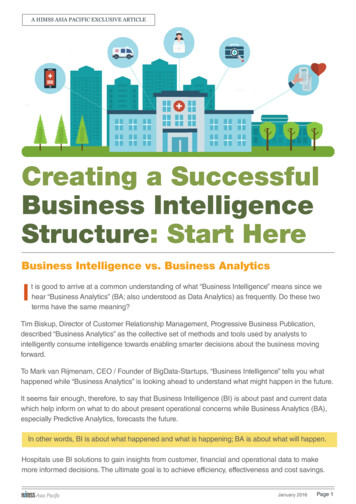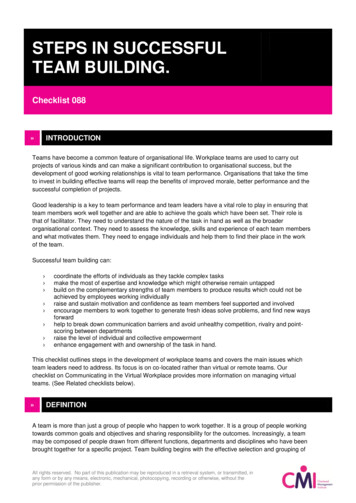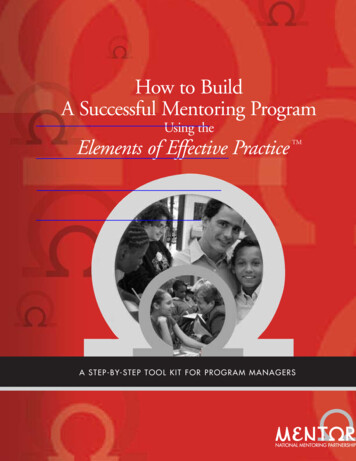
Transcription
How to BuildA Successful Mentoring ProgramUsing theElements of Effective PracticeTMA S T E P - B Y- S T E P T O O L K I T F O R P R O G R A M M A N A G E R S
MENTOR/National Mentoring Partnership1600 Duke Street, Suite 300Alexandria, VA 22314Phone: 703-224-2200Web site: www.mentoring.orgAOL Keyword: mentorOnline version of the tool kit: www.mentoring.org/eeptoolkitCopyright 2005. MENTOR/National Mentoring PartnershipAll rights reserved. Published 2005.Printed in the United States of America.Reproduction rights: Permission to reproduce or photocopy portions of this tool kit withattribution is granted by MENTOR/National Mentoring Partnership.DISCLAIMERTools and resources submitted for inclusion in this tool kit have been edited or condensed from their original versionin order to accommodate the design and intent of this publication.
CONTENTSForewordviiAcknowledgementsixSection I.11About MENTOR/National Mentoring PartnershipOur State and Local Mentoring PartnershipsResources State and Local Mentoring Partnerships National Mentoring InstituteSection II.357778910About the Tool KitWhy Create a Tool Kit?Guidelines for New—and Existing—ProgramsWhat You’ll Find in the Tool KitGlossary of TermsLet’s Get Started!Section III.Introduction to Mentoring and Program-BuildingWhat Is Mentoring Today?What Makes a Successful Mentoring Relationship?The Five Types of MentoringWhat Elements Constitute a Safe and Effective Mentoring Program?What’s the Next Step?Section IV.111111121314Start with the NeedDesign the Parameters for Your ProgramPlan How the Program Will Be Managed Select the Management Team Establish Policies and Procedures Implement Ongoing Staff Training and Professional Development Develop a Financial Plan Implement the Program Plan How to Evaluate the Program15151521212222222323Checklist of Program Progress: Program Design and Planning25Additional Resources27How to Design and Plan a Mentoring ProgramTools Located on CDTab ACONTENTSiii
Tools by Category Program Planning Program Parameters Program Planning and Management Policies and Procedures Financial Planning E-mentoringSection V.How to Manage a Program for SuccessForm an Advisory GroupDevelop a Comprehensive System for Managing Program InformationDesign a Resource Development Plan ThatAllows for Diversified FundraisingDesign a System to Monitor the ProgramCreate a Professional Staff Development PlanAdvocate for MentoringEstablish a Public Relations/Communications EffortPartner and Collaborate with Other Organizations535355575859606163Checklist of Program Progress: Program Management65Additional Resources69Tools Located on CDTab BTools by Category Advisory Group Program Information Management Resource Development Professional Staff Development Advocacy Public Relations/Communications and Marketing CollaborationSection VI.How to Structure Effective Program OperationsBuild the Right StructureRecruit Mentors, Mentees and Other VolunteersScreen Potential Mentors and MenteesOrient and Train Mentors, Mentees and Parents/CaregiversMatch Mentors and MenteesBring Mentors and Mentees Together for Mentoring Sessions That Fallwithin the Program ParametersProvide Ongoing Support, Supervision and Monitoring of MentoringRelationshipsRecognize the Contributions of All Program ParticipantsHelp Mentors and Mentees Reach Closureiv91919196100103104105106107HOW TO BUILD A SUCCESSFUL MENTORING PROGRAM USING THE ELEMENTS OF EFFECTIVE PRACTICE
CONTENTSChecklist of Program Progress: Program Operations109Additional Resources113Tab CTools Located on CDTools by Category Recruitment Screening Orientation Training Matching Activities Ongoing Support and Supervision Mentor Recognition Structured Match ClosureSection VII.Measure Program ProcessMeasure Expected OutcomesCreate a Process to Reflect on and Disseminate Findings“Gauging the Effectiveness of Youth Mentoring,” by Dr. Jean RhodesThe Nuts and Bolts of Evaluating Mentoring Programs163163163164164165Checklist of Program Progress: Program Evaluation169Additional Resources171How to Establish Evaluation Criteria and MethodsTools Located on CDTab D Program EvaluationSection VIII.Wrap-Up and FeedbackEvaluation FormEndnotes181183187CONTENTSv
FOREWORDYou have in your hands How to Build a Successful Mentoring Program Using the Elementsof Effective Practice, the latest and perhaps most important work in years to advance qualitymentoring. This comprehensive tool kit includes tools, templates and advice for implementingand adhering to the second edition of the Elements of Effective Practice—rigorous guidelines that,when followed, will help to ensure quality mentoring.The tool kit was made possible by a generous grant from the Charles Stewart Mott Foundationand is the latest offering from MENTOR/National Mentoring Partnership and the vital networkof State Mentoring Partnerships. For more than a decade, we have been leading the movement toconnect America’s young people with caring adult mentors. We serve as the “mentor’s mentor,”providing a wide range of resources and technical assistance to more than 4,300 mentoringprograms across the nation.In 1990, we joined with United Way of America to convene a blue-ribbon panel of mentoringexperts to produce the nation’s first set of rigorous mentoring guidelines, the first edition of theElements of Effective Practice. Those Elements served as the gold standard for quality mentoringfor more than a decade.Since then, the world of mentoring has changed. New types of mentoring have taken hold,requiring new guidelines. In 2003, through the generosity of the Charles Stewart MottFoundation, we again convened a blue-ribbon panel of mentoring experts to produce thesecond edition of the Elements of Effective Practice, which reflects the latest mentoring research,experience and practices. Among the experts contributing to the effort were two of the nation’stop mentoring researchers: Dr. Jean Rhodes of the University of Massachusetts, Boston, andDr. David DuBois of the University of Illinois at Chicago.Whether you are new to mentoring or an old hand, this tool kit will save you time and effort,because it contains materials and information you need to start or maintain a quality mentoringprogram. The tool kit is written to follow the format of the Elements—but it allows you to takeportions of the tool kit in a different order, depending on where you are in starting orstrengthening your mentoring program.We hope you will use the tool kit with great success. For further assistance, we encourage you toreach out to your State Mentoring Partnership or visit Mentoring.org, to find the latest resourcesfor the mentoring field. And, as always, we very much welcome your feedback.In Partnership,Gail ManzaExecutive DirectorTonya WileyVice-PresidentFOREWORDvii
ACKNOWLEDGEMENTSMENTOR gratefully acknowledges the Charles Stewart Mott Foundation for its generoussupport for the tool kit. We thank An-Me Chung, program officer of the foundation, for herleadership and vision in the development of this resource for the mentoring community.We gratefully acknowledge the guidance, feedback and unwavering support for the developmentof the tool kit provided by members of our Advisory Council:Advisory CouncilJean Lahage CohenMentoring Partnership of Long IslandSusan K. PatrickThe Connecticut Mentoring PartnershipJoyce CorlettBig Brothers Big Sisters of AmericaJean Rhodes, Ph.D.University of Massachusetts, BostonDavid DuBois, Ph.D.Community Health SciencesSchool of Public HealthUniversity of Illinois at ChicagoRosemary TownsendBaylor University Health ServicesSusan Weinberger, Ed.D.Mentor Consulting GroupChair, MENTOR Public Policy CouncilState and Local Mentoring PartnershipsWe would like to thank our network of State and Local Mentoring Partnerships for their supportof this tool kit. We extend our sincere appreciation to the following Mentoring Partnerships thatshared resources and ideas:California Governor’s Mentoring PartnershipMentoring Partnership of Long IslandThe Connecticut Mentoring PartnershipThe Los Angeles Mentoring PartnershipFlorida Mentoring Partnership, VolunteerFlorida FoundationThe Mentor Center of Palm Beach CountyThe Mentoring Partnership of New YorkIowa Mentoring PartnershipOregon MentorsThe Maryland Mentoring PartnershipTexas Governor’s Mentoring InitiativeMass Mentoring PartnershipVirginia Mentoring PartnershipMemphis Mentoring PartnershipACKNOWLEDGEMENTSix
Other ContributorsApplied Research ConsultingHarvard Graduate School of EducationBest Buddies Internationalicouldbe.org inc.Big Brothers Big Sisters of theGreater Twin CitiesiMentor.orgKinship of Greater MinneapolisBoys & Girls Clubs of AmericaUniversity of Texas at San AntonioCamp Fire Georgia CouncilYouth Development Strategies, Inc.Dare Mighty ThingsYouthFriendsFriends for YouthGirl Scouts of the USAMENTOR/National Mentoring PartnershipLead StaffProject StaffKristi Zappie-FerradinoColleen Appleby-CarrollKathy JohnsonJennifer RichterCindy SturtevantEditor’s note: All tools and resources submitted for inclusion have been edited and customizedto accommodate the needs of the tool kit.xHOW TO BUILD A SUCCESSFUL MENTORING PROGRAM USING THE ELEMENTS OF EFFECTIVE PRACTICE
Section I.About MENTOR/National Mentoring PartnershipMENTOR/National Mentoring Partnership (MENTOR),founded in 1990, is leading the movement to connectAmerica’s young people with caring adult mentors,because all children deserve the opportunity to achievetheir potential. As a result of certain life circumstances, 17.6 million young Americans today are inspecial need of mentors. Of that number, 2.5 millionalready are in mentoring relationships. The remaining15.1 million young people constitute what we call thenation’s “mentoring gap.” MENTOR exists to closethat gap. To that end, MENTOR serves as the nation’spremier advocate and resource for expanding qualitymentoring initiatives. Working with a strong networkof Mentoring Partnerships located across the UnitedStates, MENTOR leverages resources and provides thetechnical expertise, tools and innovation that mentoring programs need to serve young people in theircommunities effectively.OUR STATE ANDLOCAL MENTORINGPARTNERSHIPSA list of State andLocal MentoringTo meet the demand of proPartnerships is locatedviding mentors to the estiat the end of thismated 17.6 million youngsection.people in the United Stateswho want or need them,hundreds of new mentoring programs are startedevery year. But as existing mentoring programs arealready painfully aware, the resources to fund and staffthese ventures are scarce.There is an answer: State Mentoring Partnerships. Bybringing together public and private sector leadersacross the state, eliminating duplication of efforts andoffering centralized services, State MentoringPartnerships can help mentoring programs make themost of limited resources.State and Local Mentoring Partnerships serve as “mentoring central” for their states or communities, providing leadership, resources and a rallying point for mentoring providers in their area. State MentoringPartnerships serve a unique role as a clearinghouse forinformation and resources. They do not provide directmentoring services. Instead, they work to enable directservice mentoring organizations to: Increase the number of young people with mentorsin the state; Increase resources in the state dedicated tomentoring; Promote quality standards for mentoring programs;and Expand mentoring programming andopportunities tailored to the needs andcircumstances of young people.The result is better service, greater collaboration,smarter use of resources and more youth in qualitymentoring relationships.To find a State or Local Mentoring Partnership in yourcommunity to assist you with training, technical assistance and implementing the Elements of EffectivePractice, see the appendix at the end of this sectionor visit Mentoring.org.RESOURCES State and Local Mentoring Partnerships National Mentoring InstituteA B O U T M E N T O R / N AT I O N A L M E N T O R I N G PA RT N E R S H I P1
SECTION IState and LocalMentoring PartnershipsAlabamaMaine Mentor Alabamawww.ago.state.al.us/mentor/ Maine Mentoring Partnershipwww.mainementoring.orgArizonaMaryland Volunteer Center of Southern Arizona:The Mentoring Partnershipwww.volunteertucson.org The Maryland Mentoring ifornia Governor’s Mentoring Partnershipwww.mentoring.ca.gov The Los Angeles Mentoring Partnershipwww.mentoring.org/los angeles/ Mass Mentoring Partnershipwww.mentoring.org/mass/Michigan Mentor Michiganwww.michigan.gov/mentormichiganColorado Colorado Mentoringwww.mentoringcolorado.orgMinnesota Mentoring Partnership of Minnesotawww.mentoringworks.orgConnecticut The Connecticut Mentoring re All Our Kids, Inc.: The MidlandsMentoring Partnershipwww.allourkids.org Delaware Mentoring Councilwww.delawarementoring.orgNew YorkFlorida Florida Mentoring Partnershipwww.volunteerfloridafoundation.org Mentor Center of Palm Beach Countywww.mentoringpbc.org The Mentoring Partnership of New Yorkwww.mentoring.org/newyork/ Mentoring Partnership of Long Islandwww.mentorkids.comNorth CarolinaGeorgia North Carolina Mentoring Partnershipwww.volunteernc.org/code/mentor.htm Georgia Mentoring Partnershipwww.georgiamentoring.orgOhioIowa The Mentoring Center of Central hp Iowa Mentoring Partnershipwww.iowamentoring.orgOregon Oregon Mentorswww.ormentors.orgS TAT E A N D L O C A L M E N TO R I N G PA RT N E R S H I P S3
PennsylvaniaUtah United Way’s Campaign for Mentors (Philadelphia)www.uwsepa.org The Mentoring Partnership of g Utah Mentoring Partnershipwww.utahmentors.orgVermont Vermont Mentoring Partnershipwww.vtmentoring.orgRhode Island Rhode Island Mentoring Partnershipwww.rimentor.orgTennessee The Memphis Mentoring Partnershipwww.memphismentors.orgVirginia Virginia Mentoring Partnershipwww.mentoring.org/virginia/ Fairfax Mentoring Partnershipwww.mentorfairfax.orgWashingtonTexas Governor’s Mentoring Initiativewww.onestarfoundation.org San Antonio: Making Mentoring a Partnershipwww.utsa.edu/mentoring/4 Washington State Mentoring Partnershipwww.washingtonmentoring.orgHOW TO BUILD A SUCCESSFUL MENTORING PROGRAM USING THE ELEMENTS OF EFFECTIVE PRACTICE
SECTION INATIONAL MENTORING INSTITUTEThe National Mentoring Institute serves as theeducation, research and training arm for MENTOR/National Mentoring Partnership, offering a wealth ofproducts and services to the entire mentoring field.The Institute’s menu of resources and services includesthe following: Online Community: Offers free, online discussions on a variety of issues related to mentoring—mentor recruitment and retention, marketing,e-mentoring and risk management. Designed toexchange ideas and best practices and to posequestions to experts from the field. Visit theOnline Community at Mentoring.org/community.ONLINE SERVICES Mentoring.org: The nation’s most comprehensivesource for mentoring information and resources,focusing on the needs of mentors, caring adults,community leaders and mentoring program staff.Includes a Research Corner, with analysis of thelatest research in the mentoring field; informationon how to advocate for mentoring and securefunding; referrals to online and print resources; anE-mentoring Clearinghouse; and tools for starting,managing, sustaining and evaluating mentoringprograms. National Mentoring Database: Includes over4,300 youth mentoring programs and serves as avolunteer referral service, enabling prospectivementors to search for a local mentoring programand express an interest in learning more. Mentoring programs that agree to adhere to the Elementsof Effective Practice are invited to register for thisfree service at Mentoring.org/register. After-school Program Clearinghouse: Devoted toafter-school programs that may or may not have amentoring component. Features information onhow to implement or strengthen a mentoring program, as well as an inclusive list of resources foractivities, collaboration, curricula, research andevaluation materials for after-school programs atMentoring.org/afterschool.PRODUCT DEVELOPMENT Elements of Effective Practice: MENTOR’s hallmark product, which provides research and fieldtested guidelines on how to run safe and effectivementoring programs. Key components includeProgram Design and Planning, ProgramManagement, Program Operations and ProgramEvaluation. Available to download atMentoring.org/elements. How to Build a Succcessful Mentoring ProgramUsing the Elements of Effective Practice:A comprehensive tool kit with customizabletools and templates on how to implement andadhere to the Elements.RESEARCH AND EVALUATION Research Summit: In 2003, MENTOR convened35 leading researchers in the field for a NationalResearch Summit on Mentoring. Summit participants reviewed the current state of mentoringresearch and then articulated where mentoringresearch should be headed in the coming years.Their work was translated into several priorityareas for future research. For more informationabout the National Research Agenda for Mentoring,visit Mentoring.org/researchagenda. State-by-State Trends in Mentoring Survey:Bi-annual survey that identifies national and statetrends in mentoring as reported from our networkof mentoring programs.N AT I O N A L M E N T O R I N G I N S T I T U T E5
TRAINING AND TECHNICAL ASSISTANCE Online Training: Self-guided training for both mentors and mentees involved in either traditional faceto-face mentoring (Mentoring.org/mentor training)or e-mentoring (Mentoring.org/emc). Technical Assistance: Information, resources andsupport for MENTOR’s network of State and LocalMentoring Partnerships, which provide training andtechnical assistance to direct service mentoring programs. In addition, advisory services are providedon a contractual basis to corporations and otherorganizations interested in starting, expanding orstrengthening a large-scale mentoring initiative.MENTOR is leading the movement to connect America’s young people with caring adult mentors.For more information, please visit Mentoring.org.6HOW TO BUILD A SUCCESSFUL MENTORING PROGRAM USING THE ELEMENTS OF EFFECTIVE PRACTICE
Section II.About the Tool KitCongratulations! You’ve chosen to make a tremendous difference—or already are making that difference—in the lives of young people who can benefitgreatly from the guidance and encouragement of anurturing mentor. Few endeavors do more to shapeyoung people’s aspirations and help them realize theirpotential. In return, few endeavors reap more profound rewards for all who become involved in thementoring process—because mentoring works.Mentoring is not a new concept; it has its roots inancient Greece. And throughout the millennia, mentoring—providing guidance and counsel to a youngerindividual—has occurred spontaneously as informalrelationships: a supervisor at work who takes aninterest in a young person’s upward mobility; ateacher who takes extra time with a struggling orpromising student; an older family member who provides a shoulder to lean on when needed.In recent years, as growing numbers of people haverecognized the tremendous power of mentoring, formal mentoring programs like yours have been cropping up throughout the public and private sectors.More and more community organizations, businessesand governments are launching formal mentoring initiatives. Consequently, we have seen a growing needfor skilled mentors and effective mentoring programsthat adhere to sound management and operationpractices.WHY CREATE A TOOL KIT?Building a successful mentoring program is challenging. There are a myriad of components to establishand oversee: the actual mentoring process; mentorrecruitment and training; day-to-day operations; public relations efforts; fundraising activities; budget allocations; evaluative data collection and tracking; andmore. It may seem a bit daunting: “Where do Ibegin?” “What should I focus on first?” “How do I doall these things effectively?”The simple fact is, youth mentoring programs are farmore successful when they follow proven, effectivementoring practices and strategies. This tool kit placesat your fingertips a single source of mentoring bestpractices and tools that you can implement from thestart. The materials it contains build on the practicesestablished in the Elements ofEffective Practice, guidelinesThe appendices forfor running safe and effectiveSections IV-VII includementoring programs, firsta Checklist of Programpublished in 1990 andProgress for eachrevised and updated in thesection of the Elements.second edition in 2003.GUIDELINES FOR NEW—AND EXISTING—PROGRAMSNot only does this tool kit outline the Elements ofEffective Practice, it also is your guide to implementingthem. It is structured to aid both those who are starting a new program and those who seek to improvespecific elements of an ongoing program. Let’s take alook at how this tool kit can fill the particular needsof your program. Building a Program: Begin by asking yourselfsome questions, such as: What do I need to budgetfor and how do I get it funded? Is there a “best”way to mentor; if so, what is it? How do I recruitmentors and ensure that they’re sufficientlytrained? How do I reach out to the community forsupport? How do I engage young people in theprogram? Where will the mentoring meetings takeplace? How will I know that the mentoring relationships are working?ABOUT THE TOOL KIT7
These are just some of the questions that youshould attempt to answer before you establish amentoring program. If you’re at a loss as to what todo first, don’t panic. The tool kit will help you findthe answers and make solid decisions. When youfollow the tool kit sections, step-by-step, a solidprogram will emerge from the ground up. Each ofthe components of your mentoring initiative willfunction in ways that support the others to facilitate a well-focused, cohesive program.ELEMENTS OF EFFECTIVE PRACTICEThe first edition of Elements was developedin 1990 by a panel of mentoring expertsbrought together by MENTOR/NationalMentoring Partnership and United Way ofAmerica. It was based on solid research thataffirms the importance of accountability andresponsibility in meeting young people’s needs.For more than a decade, the initial Elementsserved as the gold standard for mentoring. Improving on Current Practices: The desire forcontinuous improvement is the hallmark of everysuccessful endeavor. The tool kit is designed so thatyou don’t need to go through the entire kit for helpin improving a specific element of your program.Do you need guidance in constructing anevaluation process that accurately measures yourresults, or benchmarks your procedures againstsimilar programs? This tool kit can help. Perhapsyou’re not receiving the support you’d like fromother community organizations or your mentorvolunteer base is falling below your needs. Maybeyou wish to raise the profile of your mentoringprogram. Or you may wish to ensure that the typeof mentoring you’re offering is the most effectivefor the youth you’re serving.Not to worry. Just keep the tool kit within easy reach.When you’re ready to make improvements in a particular area of your program, simply turn to the appropriate section. Remember, too, that the tool kit isavailable online at Mentoring.org/eeptoolkit, whereyou can download it and customize the tools to fityour needs.By carrying out the strategies detailed in this tool kit,you can be confident that your program is offering thebest mentoring possible. At the same time, we recognize that the Elements outlined in the tool kit are vastand detailed (this is to ensure the best mentoring possible for our youth). Initially, not all mentoring programs will have the resources to implement and adhereto every component of the Elements in their entirety. If8The second edition of Elements—developed bya newly formed group of many of the nation’sforemost authorities on mentoring—updates theoriginal version. It offers new ideas and practices that reflect the latest in mentoring policies,practices, experience and research. The tool kitis an excellent companion to the Elements. Acopy of the Elements is included with this toolkit, and you can download additional copies atMentoring.org/elements.that is the case with your program, we recommendthat you work toward integrating the Elements intoyour program incrementally. It will take time, but willbe more than worth the effort.WHAT YOU’LL FIND IN THE TOOL KITAs noted earlier, this tool kit builds on the Elements ofEffective Practice, which address four major components of a safe and effective mentoring program: Program Design and Planning;Program Management;Program Operations; andProgram Evaluation.HOW TO BUILD A SUCCESSFUL MENTORING PROGRAM USING THE ELEMENTS OF EFFECTIVE PRACTICE
SECTION IIThe tool kit dedicates a section to each of these components. In each section, you’ll find step-by-stepinformation on how to implement a specific component, using proven practices that help ensure a strongoverall program. Of course, how you initially plan anddesign your program willaffect the other components.Throughout the toolTherefore, in each sectionkit, you will findyou’ll find the following“mentoringtool” boxesinformation:that reference specifictools and resources. What constitutes theprogram component andBoxes withhow it relates to the othera CD iconcomponents;indicate that a tool can A Checklist of Programbe found on the CDProgress against which tomeasure your programpractices;Boxes with a Customizable tools—suchBook icon indicateas forms, checklists andthat the tool is in therelated sample documentsprint version of theon CD—to help you.tool kit as well(Select tools are alsoas on the CD.included in the printversion of the tool kit.);and Additional resources for further research andreference.For your convenience, we have included a glossary tohelp you understand how we use different terms inthis tool kit.GLOSSARY OF TERMS1Mentoring: Mentoring is a structured and trustingrelationship that brings young people together withcaring individuals who offer guidance, support andencouragement aimed at developing the competenceand character of the mentee.Types of Mentoring: Responsible mentoring canoccur in these forms: Traditional mentoring: One adult to one youngperson. Group mentoring: One adult to up to four youngpeople. Team mentoring: Several adults working withsmall groups of young people in which the adultto-youth ratio is not greater than 1:4. Peer mentoring: Caring youth mentoring otheryouth. E-mentoring: Mentoring via e-mail and theInternet.Locations of Mentoring: Mentoring can take place ina wide array of settings, such as these: Workplace; School; Faith-based organization; Juvenile corrections facility; Community setting; and “Virtual community,” where e-mentoring takesplace.ABOUT THE TOOL KIT9
Duration of Mentoring: Because relationships and asense of bonding occur over time between mentorsand mentees, the duration and consistency of eachmentoring relationship is very important. At a minimum, mentors and mentees should meet regularly atleast four hours per month for at least a year. Thereare exceptions, such as school-based mentoring, whichcoincide with the school year, and other types of special mentoring initiatives. In such special circumstances, mentees need to know from the outset howlong they can expect the relationship to last, so theycan adjust their expectations accordingly.LET’S GET STARTED!It’s an exciting venture to build a new mentoring program or fine-tune a current one, as both will result inbetter opportunities for young people. With this toolkit, you have an invaluable resource that can facilitateyour efforts. Remember, too, that you never have tostruggle with mentoring issues on your own. Manyuseful resources are available to you, including onlinetraining and community forums at Mentoring.org;mentor training and recruitment resources, as well astechnical assistance, training and guidance, fromMENTOR’s State and Local Mentoring Partnerships;and even practical advice from your mentoring colleagues. Take advantage of these resources.Visit Mentoring.org often to find the latest resourcesand research for improving your program. For example, a copy of this tool kit is available online atMentoring.org/eeptoolkit to allow you to customizethe tools to your own needs. In addition, we encourage you to provide us with feedback on the tool kit,by filling out the Evaluation Form at the end of thetool kit. Your feedback will allow us to enhance theonline version of the tool kit and respond to emergingmentoring trends.Now, roll up your sleeves and let’s get started.10HOW TO BUILD A SUCCESSFUL MENTORING PROGRAM USING THE ELEMENTS OF EFFECTIVE PRACTICE
Section III.Introduction to Mentoring and Program-BuildingWHAT IS MENTORING TODAY?Mentoring is a time-proven strategy that can helpyoung people of all circumstances achieve their potential. Mentors are caring individuals who, along withparents or guardians, provide young people with support, counsel, friendship, reinforcement and a constructive example. Conducting reasonably intensivescreening of potential mentors; Making matches based on interests that boththe mentor and the mentee share; Providing more than six hours of trainingfor mentors; and Offering post-match training and support.But mentoring is not a one-size-fits-all proposition.Every young person who would benefit from a mentoring relationship has individual needs. Effectivementoring programs offer enough flexibility to helpmeet each mentee’s personal needs, yet allow mentoring relationships to flourishwithin a safe structure.These four practices can help ensure successful mentoring relationships that e
FOREWORD You have in your hands How to Build a Successful Mentoring Program Using the Elements of Effective Practice, the latest and perhaps most important work in years to advance quality mentoring. Th

